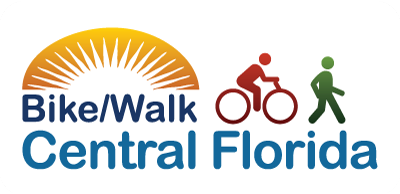Billy Hattaway, the City of Orlando’s transportation director and BWCF board chair, sat down with WMFE’s Matthew Peddie to talk about his role in making Orlando streets safer for people biking and walking.
In the interview, Hattaway talks about becoming a champion for bike and pedestrian safety in his previous role as the District 1 Secretary for the Florida Department of Transportation. Thanks in part to his hard work, FDOT will be rolling out their first Complete Streets handbook in April. Now, as Orlando’s Transportation Director, Hattaway hopes to make Orlando a “model city for improving safety for pedestrians and bicyclists.” Here are some highlights from the interview:
The Orlando metro area consistently ranks as one of the most dangerous places for pedestrians – how can we change that?

Street design and culture change don’t happen overnight. Hattaway notes that he’d like to begin focusing on high-crash corridors such as Colonial and John Young Parkway – high speed, multi-laned corridors where people are trying to cross the street between signals and at times when they may not be as visible. Street design and behavior are important factors when looking at what creates a dangerous walking environment.
Driver behavior – what needs to change?

Things like lighting, the number of crosswalks and pedestrian behavior are all important factors when it comes to safe walking. But what needs to change about driver behavior? Speed is one huge issue, according to Hattaway. He notes that drivers get off the highways and head into downtown Orlando, sometimes going two times over the speed limit. “The fact is, with signals, you’re not going to get anywhere,” said Hattaway. “The signals are going to create delay, so rushing from signal to signal is not going to get someone there any faster and all they’re doing is putting others at risk.” Moral of the story – slow down, because speeding isn’t benefiting anyone.
Peddie brings up their behavior at crosswalks and asks if drivers know what to do when they see people trying to cross. Hattaway cites poor knowledge of laws as being the main reason why people don’t yield. Using education, we can change the culture for drivers and pedestrians, but it takes a lot of time to see these improvements. Hattaway compared it to seatbelt laws – it took 20 years to see an increase from 50% to 90% of drivers wearing seatbelts.
Do you feel safe biking on all Orlando streets? 
Hattaway is no stranger to biking in Orlando – he commutes to work every day. He’s been through a bike safety course and says that he feels comfortable riding in the streets. Hattaway notes that most cyclists who ride regularly choose their routes and travel time based on what they’re willing to deal with. He uses Robinson Street in downtown Orlando as an example, stating that he rides there often but chooses not to ride at 5:00 p.m. on a Friday afternoon. Makes sense – people who drive know when to avoid getting on I-4.
According to Hattaway, there are more people cycling in downtown Orlando than there were ten years ago. Because of this, drivers are seeing them more often – becoming aware that bicyclists are there and they are sharing the space. These types of things can change driver behavior.
What role does mass transit play?

With a good relationship between LYNX, SunRail and the City’s Transportation Department, we’re off to a great start. Hattaway says the city will work collaboratively to try and find ways to improve access to the SunRail stations, connections between LYNX and SunRail, and making sure pedestrians have safe access to the stops by improving the pedestrian and bicycle network to those corridors.
And, as we often hear from our LYNX riders, what about bus shelters? Hattaway has those on his radar and knows that people are more likely to wait for buses if they can do so comfortably.
Listen to the full interview with Matthew Peddie on WMFE.

